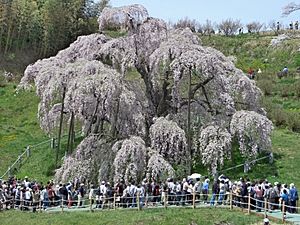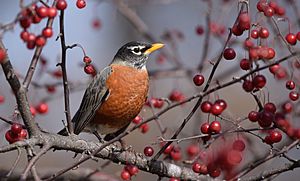Season creep facts for kids
Season creep is a term used to describe how the timing of the seasons is changing. For example, spring might start earlier than it used to. This has been seen a lot in places with mild weather, especially in the Northern Hemisphere.
Scientists who study nature's calendar (this is called phenology) have seen big changes in when seasonal events happen. These changes have been happening since the late 1900s and are still going on. In Europe, spring has been arriving about one week earlier over the last 30 years. Other studies show that spring events, like plants growing, are happening 2 to 3 days earlier each decade. Autumn events are happening 0.3 to 1.6 days later each decade.
What is Season Creep?
Season creep means that natural events tied to seasons are shifting.
- Birds might lay their eggs sooner.
- Tree buds might appear in late winter instead of spring.
- Flowering trees, like the famous cherry blossoms in Japan and Washington, D.C., are blooming earlier.
- Forests in northern areas are growing leaves sooner and keeping them longer.
- The time when farmers can grow crops has also gotten longer by 10 to 20 days in recent decades.
Even people who are not scientists, like gardeners, have noticed these changes. They are planting their spring gardens earlier. Some are even trying to grow plants that usually need warmer climates. While summer growing seasons are longer, winters are becoming warmer and shorter. This means:
- Less ice on lakes and rivers.
- Ice melting earlier in the year.
- Rivers flowing with meltwater sooner.
- Lakes reaching their highest levels earlier in spring.
Some spring events are even disappearing. For example, some lakes that used to freeze every winter now freeze less often. Also, some migratory birds are now staying in certain areas all year round instead of flying south for winter.
How Season Creep Connects to Global Warming
Scientists say that season creep is a clear sign of climate change that we can already see happening. It shows how global warming is already affecting our world.
A big study looked at 542 types of plants in 21 European countries from 1971 to 2000. It found that 78% of the times plants grew leaves, flowered, or grew fruit happened earlier. Only 3% were significantly delayed. These findings match up with the warming temperatures observed. Similar changes are happening with plants and animals in oceans, fresh water, and on land. These changes are what scientists expect from global warming.
While spring is arriving earlier in many mild parts of North America, some very cold areas (called subarctic) show different patterns. Some parts are seeing earlier springs, while others have not changed much over the last 44 years. A study in China over 40 years found that northern areas were warming more, while southern areas were cooling. This means the temperature difference between north and south is getting smaller there. This study also confirmed that season creep is linked to warming.
Possible Problems from Season Creep
Longer growing seasons and shorter winters might seem good at first. However, season creep can cause serious problems for people and nature.
- Water Supply: In the Western United States, earlier snowmelt could mean that water from melted snow flows into rivers up to two months sooner. This could greatly affect how we get electricity from water, how we use land, farming, and managing our water.
- Wildfires: Since 1980, earlier snowmelt and warmer weather have also led to longer and more serious wildfire seasons in some areas.
Season creep can also harm plant species.
- Plant reproduction: If flowers bloom too early, important pollinators like honey bees might not be active yet. This could mean plants don't get pollinated, which affects their reproduction and ability to make seeds or fruit.
- Plant health: Shorter and warmer winters can affect how trees prepare for cold weather (called cold hardening). This could make them more likely to be damaged by frost if a very cold winter still happens.



